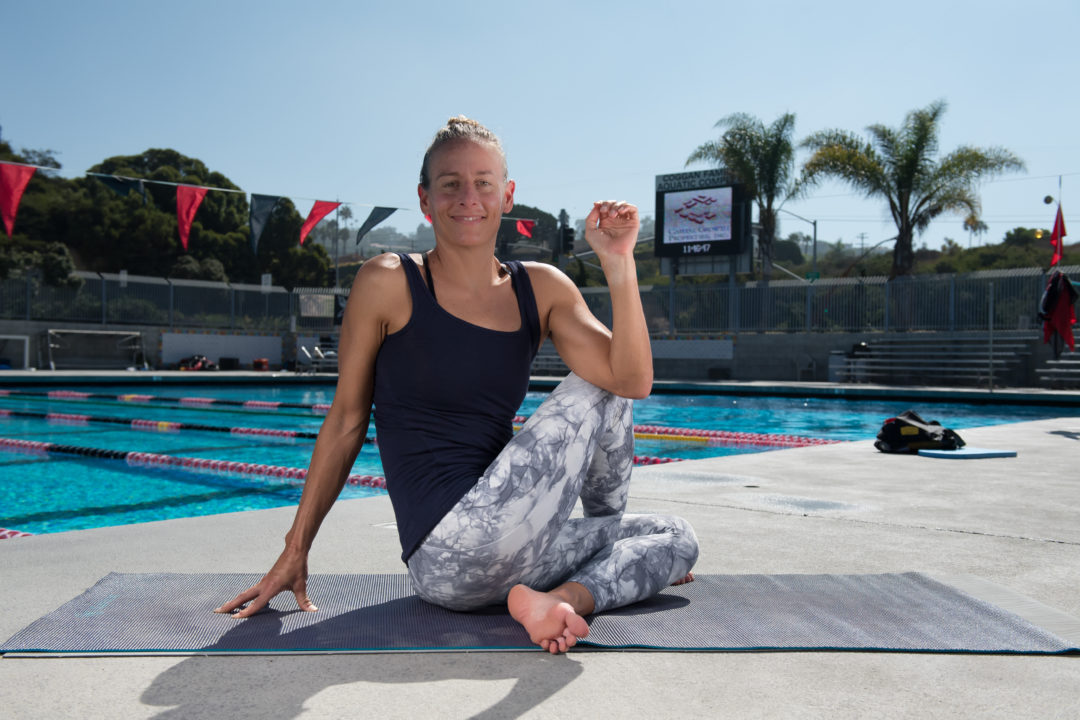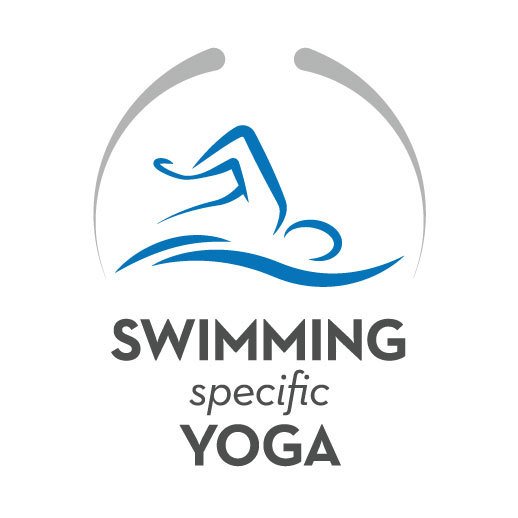In our first two yoga for masters swimmers articles you learned how a swimming-specific yoga practice can help develop both your mobility and breathing efficiency.
In the final article of this series you will learn how a swimming-specific yoga practice can also help prevent injury.
Performance is important, but many masters swimmers I work with have told me their main goal is to be able to train for as long as possible as the years add up.
There are several different areas of the body that masters athletes commonly injure including the shoulders, low back and knees. In this article I will not focus on the specifics of these injuries, but instead discuss injury prevention in a more global way.
In the previous two articles it was discussed how one of the biggest challenges for a masters swimmer is time restraints. Your in water work is and should be the priority. The crux of the matter is if you suffer an injury you can’t get the work done that is necessary to achieve your goals.
Now it is time to find out how a yoga for masters swimmers practice can help keep you in the water for many years to come.
*Although I have coached swimming for the last three decades and am now a certified and practicing yoga therapist I am not a medical health professional. Yoga is one way that can help prevent injury, but if you are experiencing pain you should seek the advice of a doctor or physiotherapist.
Body Awareness
In quest to push past what we perceive as our physical limits we often ignore what our body is trying to communicate. It is important to overcome greater challenges in training, but it is essential to do so in a healthy way.
Stepping outside of your comfort zone consistently is something you need to do to excel, but ignoring what your body is telling you is not an effective way to do so. This is where a major misunderstanding can happen when acknowledging the signals the body is giving you. Coaches and swimmers often think listening to your body means backing off as soon as you feel discomfort.
If your intention is to achieve specific goals this will not be the case. Instead you will learn to break through barriers in a much more intelligent way.
By respecting what you are feeling you will know when it is time to truly back off, but also when it is time to attack your training in a more intense manner. Being able to recognize these signals can also teach you how to control your movement patterns, especially when fatigue hits.
Another advantage of developing your body awareness is you can begin to identify imbalances and possible vulnerabilities you may have to injury. Being able to do this will enable you to address them before an injury occurs.
How a Yoga for Masters Swimmers Practice Helps
A yoga practice for masters swimmers will help you develop your body awareness in a few different ways.
The first is the use of a body scan. This is a simple technique where you bring your awareness into the body and notice how you feel, truly taking the time to listen to the body. This then gives you a foundation of awareness to use throughout your practice and at the end of your practice to understand how your body has responded.
Another way strategy is to notice how the same pose feels on one side of the body and how that differs from the other. This is a way of sensing imbalances in the body and will give you a foundation of awareness to be able to begin to address them.
The session below uses the techniques I have discussed to help you increase your body awareness.
Balance
Balance within the body and in your training is a key to preventing injury.
One of the biggest reasons swimmers experience overuse injuries is because of an imbalance between the strength in the front of the body (anterior) and the lack of strength in the back of body (posterior). It is common to see many swimmers who have overdeveloped muscles that create propulsion, such as the pecs and quads, while at the same time having underdeveloped stabilizing muscles, such as the rhomboids, lower traps, glutei and hamstrings.
Another imbalance that can leave you vulnerable to injury is between the sides of the body. Creating ways of first identifying these imbalances and then addressing them is an essential part of effective injury prevention.
To incorporate a balanced training program you should ensure that you are focusing on areas that complement one another. If you implement a strength training program balance that by incorporating some mobility work. When you are in a heavy phase of training create balance by taking time to recover effectively.
How a Yoga for Masters Swimmers Practice Helps
A yoga for masters swimmers practice can help you create balance by having sessions with different intentions. As discussed in the section on body awareness a yoga practice can give you tools to identify different imbalances in the body you can then adjust your practice to address those imbalances.
The video below provides you with a sequence that is focused on balancing the upper body through both opening the front of the body and strengthening the back of the body. In a swimming-specific yoga practice there are elements that focus on these aspects since they are common needs for swimmers.
Incorporating different styles of yoga into your training will also give you the opportunity to address areas that you need to balance your overall training plan. If you are tight and have a limited range of motion sessions that focus on mobility are ideal. If you need to create stability in different areas of the body classes that focus on strength are appropriate and if you are searching for a way to address recovery you can do that through specific classes as well.
Recovery
Swimmer and hard worker are most often synonymous. To become a proficient swimmer you have to put in the work, step outside your comfort zone consistently and challenge both your mind and body over and over again.
This is one of the reasons why many injuries masters swimmers experience are caused by overuse and over reaching in training.
As much as you may not like to admit you know rest plays an important role in your training. You first overload the body then give it time to recover, adapt and become stronger. Even though this is common knowledge many do not proactively address recovery.
One of the reasons for this is because of the busy life you live. You have found a way to fit in the work you need to do, but when is there time for specific recovery work? To experience the benefits you can gain from a recovery session you do not need to invest a lot of time and things such as breathing practices can actually be done in bed before you go to sleep.
How a Yoga for Masters Swimmers Practice Helps
A yoga for masters swimmers practice can help you recover by focusing on the parasympathetic nervous system, which is responsible for recovery. Yoga helps activate this relaxation response (Lazar et al. 2000; Melville et al. 2012). One of the ways this is accomplished is through the connection to the breath.
By slowing the speed of the breath you activate a relaxation response (Van Diest et al. 2014)
Yoga is also a great to way to help release muscle tension. Combining restorative yoga poses with body scanning helps develop greater body awareness. With that increased awareness you can start to identify where you are holding tension. Once you have identified areas of tightness work with your breath to intentionally relax those areas.
Sleep is your most important and effective recovery tool, but many of us have trouble falling asleep. These practices can be a great way to help you fall asleep with greater ease.
The video below is a gentle practice that will help with your recovery.
…
Lazar, S.W., Bush, G., Gollub, R.L., Fricchione, G.L, Khalsa, G., Benson, H. 2000. Functional brain mapping of the relaxation response in meditation. 11(7): 1581-1585
Melville, G.W., Chang, D., Colagiuri, B., Marshall, P.W., Cheema, B.S. 2012. Fifteen minutes of chair-based yog postures or guided meditation performed in the office can elicit a relaxation response. Ev-BasedCompl & Alt Med. DOI: 10.115/2012/501986
Van Diest, I., Verstappen, K., Auber, A.E., Widjaja, D., Vansteenwegen, D., Vlemincx, E. 2014. Inhalation/exhalationratio modulates effect of slow breathing on heart rate variability and relaxation. App Psychophys Biofeed. DOI: 10.1007/s10484-014-9253-x
…
This Yoga for Swimmers article is brought to you by Swimming-Specific Yoga the world’s top resource for online yoga classes and content designed for swimmers and multi-sport athletes.


